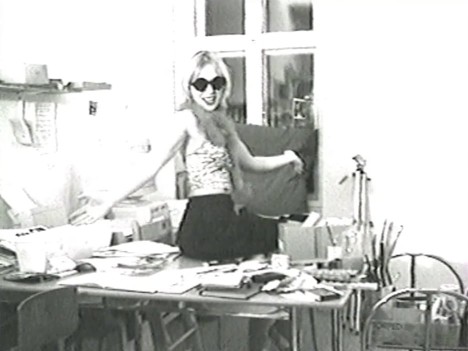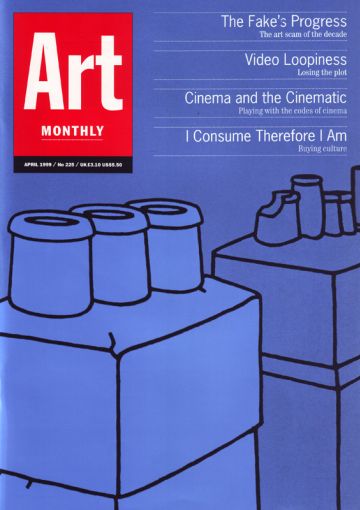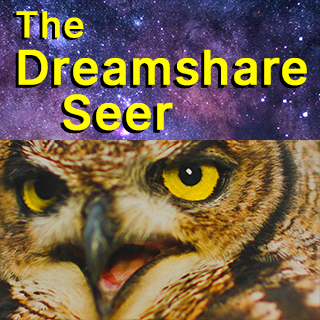Feature
Video After Diderot
According to Dave Beech video projection will be a defining embarrassment for the 1990s like shoulder pads were for the 1980s

Annika Ström, Artist Musical, 1997
Video art used to be routinely shoved into the corner of the gallery on little monitors. Now, with the development of the looped tape and the use of large-scale video projection, it has learnt how to give painting and sculpture a run for their money. Video projection is to 1990s art what shop display was to the art of the 1980s: a trademark by default. More than likely video projection will be a defining embarrassment, like shoulder pads and big hair, not just for being there but for being everywhere. The loop is more fundamental, though, because in many cases it is an integral part of the work. Brian Ashbee blames his mum.
Ashbee’s lament for the loop, published recently in Art Review[1], kicks off with his mum because when she took him to the cinema as a child they would arrive mid-movie. Michael O’Pray, writing in Art Monthly (AM224), seems to relish the very same experience but instead of his mum, he refers to those fathers of loopiness, André Breton and Jacques Vaché. For what it’s worth, I remember doing the same thing, with my brother. Following a story from middle to end, then from the beginning back to the middle, is nothing like watching a looped video which has no beginning, middle or end.
The word ‘narrative’ gets bandied about in all areas of contemporary art, mostly in reference to art with no narrative structure whatsoever. Cindy Sherman’s ‘Untitled Film Stills’ and Bill Woodrow’s early sculptures might suggest innumerable stories but they certainly do not tell any. What they are missing is what Frank Kermode calls ‘tick-tock’. The difference between the two sounds is completely fictional. But this is how we make the clock speak our language. What’s more, tick-tock is a plot with a beginning, a middle and an end - the interval between is the middle. Kermode immediately jumps in to announce that tick isn’t much of a beginning, tock isn’t much of an ending and tick-tock isn’t much of a plot, but he’s a litrary critic and in art you get used to small victories.
In the early years of the cinema it made sense for Soviet montage film-makers to argue that the edit was everything. Without the edit there would be no plot, except perhaps of a very unwieldy kind. It is after the discovery of the edit that film-makers can debate whether to use it dialectically or naturalistically. Nowadays the edit isn’t everything. It was only so before sound and before acting had been fully adapted to the new situation: now it is usually third in line to dialogue and character[2], or further behind in many cases, after mise-en-scène and the soundtrack. Video art, it appears to me, has typically - or stereotypically, anyway - harked back to the era of montage (dialogue, and especially character, being at a minimum), unless it harks back to the filmic stone-age when a stationary camera was placed in front of an event and recorded it.
Cinemagoers would be surprised to know, this has been done on purpose. In fact, for the most part, though this is changing, there seems to be an inverted economy in operation when artists, rather than entertainers, get hold of a camera. Bill Viola’s dying mum in the Nantes Triptych is real but her actual character is not transposed into its filmic equivalent. As for plot, the sequence is little more than a single tick-tock made up of three stone-age loops read from left to right. Bruce Nauman’s clown, on the other hand, whose only dialogue is the word ‘no’ repeated endlessly, is quite a character, making us in turn laugh and shudder depending on whether he seems to be saying no to a naughty child or a violent assailant. Character doesn’t have to be expressed emotionally, it can be done behaviourally. Paul McCarthy and Mike Kelley’s Heidi develops the characters of the two children and the old man in a cumulative series of brutal encounters. Its lack of a plot, therefore, is different from that of a video art loop and closer to the murderous road-movie.
It is too easy to blame the preponderance of the video loop on the modes of attention developed in galleries for the convenience of painting and sculpture. The loop wouldn’t have emerged if it was merely a function of the institution. Art demands pedigree, and the loop has pedigree. One of the reasons why Performance artists in the 1960s and 1970s looked so glum was because they went along with the modernist maxim that ‘art is concerned with the HOW and not with the WHAT’[3] which set Performance against theatre just as abstraction had set itself against realism: painting wasn’t to be valued in terms of what it pictures (don’t try this at home, you’d end up throwing your photo-albums in the bin). So, Performance came to be all act and no acting (real events performed in real time), hence so much endurance - for the artist and audience alike.
If it is pedigree you are looking for, the refusal of the grammar of filmic narrative entailed in the video loop goes back to art’s version of the Norman Conquest, the birth of Modernism. And if that isn’t enough, a good case can be made for going back further to what Michael Fried called ‘the beginnings of the prehistory of modern painting’[4], articulated in the writing of Diderot. In his early treatises on the theatre, Diderot urged playwrights to turn away from surprising turns of plot, reversals and revelations, and instead seek, in Fried’s words, ‘visually satisfying, essentially silent, seemingly accidental groupings of figures ... expressive movement or stillness as opposed to mere proliferation of incident’[5]. In painting this means enthralling the viewer without addressing the beholder at all. Hence, pictures of individuals and groups absorbed in their own activities and distractions succeed where theatrical images employing all the painterly pyrotechnics of the day fail.
Diderot does not propose that theatrical techniques have no effect, only that their accomplishments are shallow. His schema is an explicit argument for a hierarchy of forms of cultural address and their corresponding forms of attention by the audience or beholder. At one time Diderot would have been criticised for setting up a regime of taste, but taste needn’t come into it. Accusations of anti-intellectualism or populism follow the same contours. What assures the cultural value of Steve McQueen’s reworking of Buster Keaton’s comic routine, in Deadpan, is not only that it isn’t funny but that it systematically eliminates the plot by arranging its constituent camera angles end to end rather than editing them together for comedic or dramatic effect. lt could be saved, presumably, if McQueen responded in a frightened or relieved double-take after the event, but he just stands there glumly, like a 1970s Performance artist.
That glumness, I have suggested, has a good pedigree, which is shared by McQueen’s other signs of not joining-in, as if cultural aloofness was the test of cultural intelligence (not to mention taste). Who in their right mind, then, would be mongrel enough to smirk, to respond, to join in, to get right in there amongst the cultural blood and guts? Well, the likes of BANK and the Chapman brothers have elected themselves, especially in their videos, but there is nothing more culturally mongrel than the new work by Brian Dawn Chalkley. Brian became a cross-dresser two years ago, with the surprising result that Dawn is trying to wean him off Modernism. Their video, I Probably Want Perfection in Everything and a Little Bit More: Maybe That’ll be My Downfall, combines the real-time endurance of Dawn sprawled out, seemingly dumped in the forest, with a voice-over telling the story of her being picked up at a club. The personable narrative is fluent, while the modernist performance is tortuous: it’s a mongrel with nuance.
Jeanette Parris doesn’t have Brian’s Modernism to deal with, so she has been working with character, dialogue and plot for several years now. An episode in which an actor bares his soul to a mute doll doesn’t turn into farce because it is played straight. Parris is going straighter, though, scripting her own soap opera, set in a greasy spoon in Camberwell. Nicholas Bolton doesn’t go that far down the path to narrative, his videos are stranger - sometimes downright bizarre. If you’ve never seen a man singing love songs while trapped under a chaise-longue, you’ll know what I mean. Another work brings Chris Marker in contact with a stand-up comedian, as Bolton tells a joke which is shot one word at a time; this is a story literally edited together. But there is currently no one who is interlocking threads of narrative better than the Swedish artist Annika Strom. Documentary, character acting, interview, songs and montage interrupt one another in what initially appears to be a relativistic hotch-potch, only to build into a patterned investigation of the hopes, habits, actions and ambitions which put the tick and tock into our lives.
Other artists working with narrative tend to use a more reduced palette: Kerry Stewart’s videos combine mise-en-scène with monsters; Gary Perkins builds miniature sets which he films with a psychological edge; Matt Calderwood acts out events which have a beginning, middle and end, such as appearing tooled-up with an angle-grinder behind a sheet of glass which he attacks meticulously until eventually disappearing from us; John Beagles & Graham Ramsay have created a stable of weird characters who run amok in their videos; Runa Islam enthralls us with tiny fragments of filmic significance; Calli Travlos makes portraits with conversation. And that’s just a small portion of what’s going on at the moment. Anyone who complains that artists are reluctant to engage with narrative ought to get out more. The problem is not that there is a dearth of narrative but that the modes of attention which narrative mobilises have been devalued in art practice and handed over to popular forms. I don’t blame my mum, I blame Diderot and his followers.
Dave Beech is an artist.
[1] Brian Ashbee, ‘Artists’ Film and Video (Part One)’, Art Review, February 1999.
[2] See Karel Reisz & Gavin Millar, Technique of Film Editing, Focal Press, 1953, 1968, p15.
[3] Josef Albers, quoted in RoseLee Goldberg, Performance Art, Thames & Hudson, 1979, 1993, p121.
[4] Michael Fried, Absorption and Theatricality: Painting and Beholder in the Age of Diderot, University of California Press, 1980, p xi.
[5] Ibid, p78.
First published in Art Monthly 225: April 1999.









